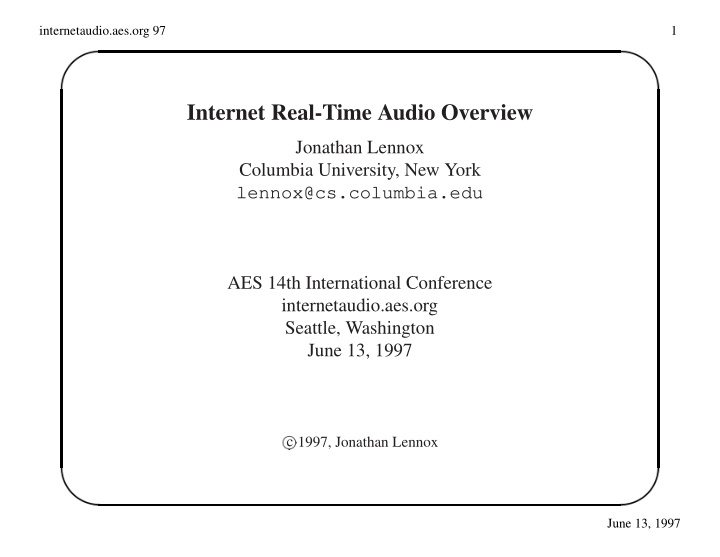



' $ internetaudio.aes.org 97 1 Internet Real-Time Audio Overview Jonathan Lennox Columbia University, New York lennox@cs.columbia.edu AES 14th International Conference internetaudio.aes.org Seattle, Washington June 13, 1997 � 1997, Jonathan Lennox c & % June 13, 1997
' $ internetaudio.aes.org 97 2 Internet Real-time Audio Overview � Internet Standards Process � Audio Compression � Real-time Streams & % June 13, 1997
' $ internetaudio.aes.org 97 3 IETF Standards Process Not every RFC is an Internet Standard! � 53 official standards; 2149 RFCs � Best Current Practice RFC, “Experimental,” “Historic,” “Informational” Stages of Internet Standards Process � Proposed Standard � Draft Standard � Standard & % June 13, 1997
' $ internetaudio.aes.org 97 4 Differences between Standards Bodies IETF AES ITU Decision-making Consensus Voting Voting Participation Open (any Broad (any Small (national attendee) AES member) PTTs and large companies) Availability of On the Available for Available for Standards Internet Purchase Purchase Availability of On the Committee only Committee only Drafts Internet Speed Rapid Slow Slow & % June 13, 1997
' $ internetaudio.aes.org 97 5 Compression: motivations Current Internet: about 20-30 kbps throughput per user (V.34 modems and typical share of backbone) Local Networks, Internet II: better, but still not unlimited: Ethernet 10/100 Mbps; OC-12 622 Mbps Uncompressed voice-grade audio: 64 kbps Uncompressed CD-grade audio: 1.4 Mbps & % June 13, 1997
' $ internetaudio.aes.org 97 6 Compression: tradeoffs � compression ratios vs. audio quality vs. CPU requirements vs. delay � real-time encoding (necessary for interactivity) vs. pre-encoding (a possibility for some applications, but reduces flexibility) � dedicated hardware vs. software on general hardware & % June 13, 1997
' $ internetaudio.aes.org 97 7 Compression: general techniques � companding: non-linear quantization ➠ � -law (G.711) � simple algorithmic: ADPCM � model: model voice, extract parameters � subband: split signal into bands and code individually; make use of masking properties of human ear � entropy reduction: exploit statistical correlations; pack losslessly. Necessary for professional work / “Golden Ears” . . . & % June 13, 1997
' $ internetaudio.aes.org 97 8 Compression: open standards coding kb/s use PC-10 2.4 robotic, secure telephone GSM 13.0 European mobile phone G.729 8.0 mobile telephony G.723.1 5.3/6.3 videophones MPEG L3, MPEG 2, . . . � 128.0 near-CD stereo / multichannel AC-3 � 384.0 DVD & % June 13, 1997
' $ internetaudio.aes.org 97 9 Compression: proprietary standards coding company kb/s use RealAudio Progressive 10 / 20 “AM”/“FM” Radio RT24 Voxware 2.4 kbps pre-recorded speech & % June 13, 1997
' $ internetaudio.aes.org 97 10 Motivations for Real-time Protocols � A late packet is as bad as a lost packet for real-time steams � Current Internet provides no loss or delay guarantees (made cheap, early, ubiquitous implementation possible) � TCP - provides reliable transfer (eventually); not suitable for real-time data & % June 13, 1997
' $ internetaudio.aes.org 97 11 Real-Time Transport Protocol — RTP lightweight: specification and implementation flexible: provide mechanism, don’t dictate algorithms protocol-neutral: UDP/IP, IPX, ATM-AALx, . . . scalable: unicast, multicast from 2 to � 1000 separate control/data: some functions may be taken over by conference control protocol secure: support for encryption, possibly authentication & % June 13, 1997
' $ internetaudio.aes.org 97 12 RTP functions � segmentation/reassembly done by UDP (or similar) � resequencing (if needed) � loss detection for quality estimation, recovery � intra-media synchronization: remove delay jitter through playout buffer � intra-media synchronization: drifting sampling clocks � inter-media synchronization (lip sync between audio and video) � quality-of-service feedback and rate adaptation � source identification & % June 13, 1997
' $ internetaudio.aes.org 97 13 Delay, Loss, and Jitter � Very situation-dependent — “What is the delay like on the Internet?” is like “What is the weather like in the United States?” � Can change rapidly due to behavior of distant hardware, software � Can change due to your own traffic � Measuring one-way delay is very difficult — delay is assymetric & % June 13, 1997
' $ internetaudio.aes.org 97 14 Multicasting — connections between multiple receivers � one-to-many; few-to-many; all-to-all � host joins group with IGMP (Internet Group Membership Protocol); broadcasts to router � Routers maintain knowledge of all destinations; no hierarchical routing protocols yet � MBone — most core Internet routers don’t support multicast today; “tunnel” multicast transmissions through unicast & % June 13, 1997
' $ internetaudio.aes.org 97 15 Quality of Service � Provide guaranteed data rates, bounds for delay � Very hard problem — 100,000 streams through typical core routers � Flow agglomeration — helps somewhat & % June 13, 1997
' $ internetaudio.aes.org 97 16 RSVP — Resource Reservation Protocol — control QoS network of routers receivers R D data sender S R R D Data (multicast) PATH RESV � Receiver initiates QoS request � Designed to work with Multicast � Many questions about scalability & % June 13, 1997
' $ internetaudio.aes.org 97 17 RTSP — Real-Time Streaming Protocol � “Internet Remote Control” — control multimedia streams � Media Servers – VOD servers (pre-recorded) – Live Feeds (concerts, TV, etc) � Desirable to control media servers – Content descriptions – Start, stop, record, pause � media stream and sessions defined by a RTSP URL rtsp://media.example.com:554/twister/autrack � Suitable for professional applications – SMPTE timecode – Remote digital editing & % June 13, 1997
Recommend
More recommend